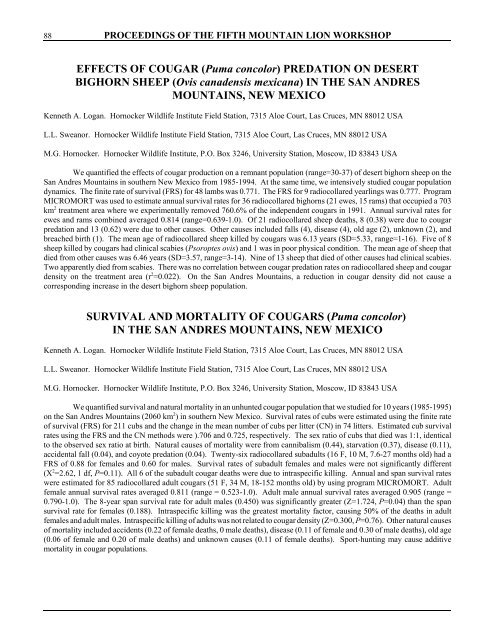Proceedings of the fifth mountain lion workshop: 27
Proceedings of the fifth mountain lion workshop: 27
Proceedings of the fifth mountain lion workshop: 27
You also want an ePaper? Increase the reach of your titles
YUMPU automatically turns print PDFs into web optimized ePapers that Google loves.
88 PROCEEDINGS OF THE FIFTH MOUNTAIN LION WORKSHOP<br />
EFFECTS OF COUGAR (Puma concolor) PREDATION ON DESERT<br />
BIGHORN SHEEP (Ovis canadensis mexicana) IN THE SAN ANDRES<br />
MOUNTAINS, NEW MEXICO<br />
Kenneth A. Logan. Hornocker Wildlife Institute Field Station, 7315 Aloe Court, Las Cruces, MN 88012 USA<br />
L.L. Sweanor. Hornocker Wildlife Institute Field Station, 7315 Aloe Court, Las Cruces, MN 88012 USA<br />
M.G. Hornocker. Hornocker Wildlife Institute, P.O. Box 3246, University Station, Moscow, ID 83843 USA<br />
We quantified <strong>the</strong> effects <strong>of</strong> cougar production on a remnant population (range=30-37) <strong>of</strong> desert bighorn sheep on <strong>the</strong><br />
San Andres Mountains in sou<strong>the</strong>rn New Mexico from 1985-1994. At <strong>the</strong> same time, we intensively studied cougar population<br />
dynamics. The finite rate <strong>of</strong> survival (FRS) for 48 lambs was 0.771. The FRS for 9 radiocollared yearlings was 0.777. Program<br />
MICROMORT was used to estimate annual survival rates for 36 radiocollared bighorns (21 ewes, 15 rams) that occupied a 703<br />
km 2 treatment area where we experimentally removed 760.6% <strong>of</strong> <strong>the</strong> independent cougars in 1991. Annual survival rates for<br />
ewes and rams combined averaged 0.814 (range=0.639-1.0). Of 21 radiocollared sheep deaths, 8 (0.38) were due to cougar<br />
predation and 13 (0.62) were due to o<strong>the</strong>r causes. O<strong>the</strong>r causes included falls (4), disease (4), old age (2), unknown (2), and<br />
breached birth (1). The mean age <strong>of</strong> radiocollared sheep killed by cougars was 6.13 years (SD=5.33, range=1-16). Five <strong>of</strong> 8<br />
sheep killed by cougars had clinical scabies (Psoroptes ovis) and 1 was in poor physical condition. The mean age <strong>of</strong> sheep that<br />
died from o<strong>the</strong>r causes was 6.46 years (SD=3.57, range=3-14). Nine <strong>of</strong> 13 sheep that died <strong>of</strong> o<strong>the</strong>r causes had clinical scabies.<br />
Two apparently died from scabies. There was no correlation between cougar predation rates on radiocollared sheep and cougar<br />
density on <strong>the</strong> treatment area (r 2 =0.022). On <strong>the</strong> San Andres Mountains, a reduction in cougar density did not cause a<br />
corresponding increase in <strong>the</strong> desert bighorn sheep population.<br />
SURVIVAL AND MORTALITY OF COUGARS (Puma concolor)<br />
IN THE SAN ANDRES MOUNTAINS, NEW MEXICO<br />
Kenneth A. Logan. Hornocker Wildlife Institute Field Station, 7315 Aloe Court, Las Cruces, MN 88012 USA<br />
L.L. Sweanor. Hornocker Wildlife Institute Field Station, 7315 Aloe Court, Las Cruces, MN 88012 USA<br />
M.G. Hornocker. Hornocker Wildlife Institute, P.O. Box 3246, University Station, Moscow, ID 83843 USA<br />
We quantified survival and natural mortality in an unhunted cougar population that we studied for 10 years (1985-1995)<br />
on <strong>the</strong> San Andres Mountains (2060 km 2 ) in sou<strong>the</strong>rn New Mexico. Survival rates <strong>of</strong> cubs were estimated using <strong>the</strong> finite rate<br />
<strong>of</strong> survival (FRS) for 211 cubs and <strong>the</strong> change in <strong>the</strong> mean number <strong>of</strong> cubs per litter (CN) in 74 litters. Estimated cub survival<br />
rates using <strong>the</strong> FRS and <strong>the</strong> CN methods were ).706 and 0.725, respectively. The sex ratio <strong>of</strong> cubs that died was 1:1, identical<br />
to <strong>the</strong> observed sex ratio at birth. Natural causes <strong>of</strong> mortality were from cannibalism (0.44), starvation (0.37), disease (0.11),<br />
accidental fall (0.04), and coyote predation (0.04). Twenty-six radiocollared subadults (16 F, 10 M, 7.6-<strong>27</strong> months old) had a<br />
FRS <strong>of</strong> 0.88 for females and 0.60 for males. Survival rates <strong>of</strong> subadult females and males were not significantly different<br />
(X 2 =2.62, 1 df, P=0.11). All 6 <strong>of</strong> <strong>the</strong> subadult cougar deaths were due to intraspecific killing. Annual and span survival rates<br />
were estimated for 85 radiocollared adult cougars (51 F, 34 M, 18-152 months old) by using program MICROMORT. Adult<br />
female annual survival rates averaged 0.811 (range = 0.523-1.0). Adult male annual survival rates averaged 0.905 (range =<br />
0.790-1.0). The 8-year span survival rate for adult males (0.450) was significantly greater (Z=1.724, P=0.04) than <strong>the</strong> span<br />
survival rate for females (0.188). Intraspecific killing was <strong>the</strong> greatest mortality factor, causing 50% <strong>of</strong> <strong>the</strong> deaths in adult<br />
females and adult males. Intraspecific killing <strong>of</strong> adults was not related to cougar density (Z=0.300, P=0.76). O<strong>the</strong>r natural causes<br />
<strong>of</strong> mortality included accidents (0.22 <strong>of</strong> female deaths, 0 male deaths), disease (0.11 <strong>of</strong> female and 0.30 <strong>of</strong> male deaths), old age<br />
(0.06 <strong>of</strong> female and 0.20 <strong>of</strong> male deaths) and unknown causes (0.11 <strong>of</strong> female deaths). Sport-hunting may cause additive<br />
mortality in cougar populations.

















